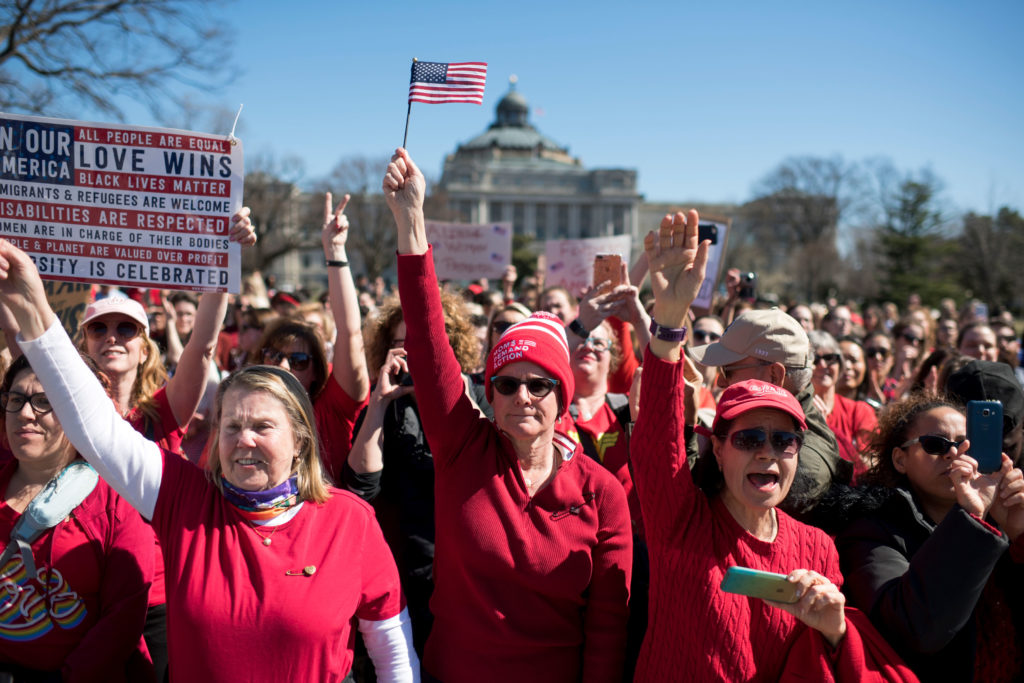For many, the election of Donald Trump to the presidency served as devastating news. For many on the left who have sought an opportunity to gain political relevancy, however, the election of Trump is a tremendous opportunity.
Like all good games, politics requires an opponent. Today, the left and those looking to gain politically, financially, or both have found in Trump a villain against which one can rage.
For eight years, the only viable route for liberal political advocacy was an assertion that things were great, but could have been better.
As liberalism ruled the day in Washington, the only path toward leftist political advocacy required a near constant assertion that the barbarians were at the gates—that without these well-funded and organized groups, government would fall into the hands of the Neanderthals of the GOP who would send women back to the kitchens, black Americans back to Jim Crow, gays back into the closet, and illegal immigrants back to their country of origin.
However, before Trump, then-president-elect, had even assumed office, the war drums began beating and the left was mobilizing for action. Against what, exactly, has been scarcely defined. “Hate” or “bigotry” have become the go-to examples of what countless groups and lawmakers are supposedly working to thwart.
In keeping with the vagueness of the left’s call to action, organizers coordinated a “strike” March 8 to highlight alleged social inequalities currently endured by American women. The “A Day Without a Woman”event was designed to encourages women to “strike” and skip work to underscore the importance of women in the workplace.
Despite the event’s seeming commitment to the advancement of equality in America, the group organizing the event, the Women’s March group, has received criticism for its lack of inclusion.
“We believe that creating workforce opportunities that reduce discrimination against women and mothers allow economies to thrive,” the Women’s March website posits. “Nations and industries that support and invest in caregiving and basic workplace protections—including benefits like paid family leave, access to affordable childcare, sick days, health care, fair pay, vacation time, and healthy work environments—have shown growth and increased capacity.”
The event calls for women to skip work, to refrain from shopping, and to wear red in solidarity with other women observing the event.
This group, which purports to work to reduce discrimination, came under fire in January for excluding a feminist group that was pro-life—the New Wave Feminists.
>>>Read more about how the Women’s March excluded a pro-life women’s group
According to the Pew Research Center, 39 percent of women opposed abortion in 2016—a number that has remained more or less static over the last 20 years.
Just months after the group was forced to explain why “pro-choice” meant excluding those who chose a different perspective on the abortion issue, the Women’s March group now must explain why the group dedicated to female empowerment has partnered with a political advocacy group absent a single female in a leadership position.
The Action Network, a Washington, D.C.-based group promoting “progressive online organizing” is managing the event’s website and the email list from which the group can solicit donations.
The group is headed by five men tasked with leadership roles, and despite the Women’s March’s assertion that the March 8 “A Day Without a Woman” event is not an “anti-Trump” event, the Action Network has been active in organizing anti-Trump events since Trump’s election in November.

Demonstrators gather for a “A Day Without a Woman” rally March 8 outside the U.S. Capitol. (Photo: Tom Williams/CQ Roll Call/Newscom)
Without noting that his group is bereft of a single woman in a leadership position, Brian Young, executive director of the Action Network, said, “The Women’s March is a great real-world example of what we were trying to build from the beginning.”
Despite the grandstanding, neither the Women’s March nor its male-dominated partner organization have released concrete metrics or goals to indicate what workplace equality actually entails.
By contrast, conservative groups have used statistics to showcase the reality of women in the workplace—a reality that seems to differ greatly from the preferred narratives upon which the left frequently relies.
On its website, Concerned Women of America, a conservative women’s group, shined a sobering light on the plight of women in the workplace:
The U.S. has the highest proportion of women in senior management positions (43 percent) of any country in the Organization for Economic Cooperation and Development (women comprise 47 percent of the U.S. labor force); the U.S. was ranked eighth globally in gender equality by the World Economic Forum; 24 percent of working American women are in professional fields (compared to only 16 percent of working American men); 46 percent of American firms are owned or co-owned by women.
Karin Agness, a resident fellow at the Harvard Institute of Politics and founder of the Network of Enlightened Women, noted that she would not be striking on Wednesday and called for women looking to make a difference to offer more substantial efforts to promote female empowerment than merely staying home.
“If participants in the Women’s March are truly concerned about being behind in the workplace, they could take concrete actions that would immediately be more productive for women,” Agness noted, adding:
Marchers could mentor junior female colleagues, giving career advice. They could ask to meet with a boss to discuss ways to take on more responsibility and in turn, earn more money. Or they could work an extra 30 minutes. According to the 2015 American Time Use Survey by the U.S. Bureau of Labor Statistics, men worked longer hours than women. Hours worked is certainly a factor considered in pay decisions.
Though the Women’s March has worked to posture as advocates for increased opportunities for women, it has a history of discrimination. And when considering how to best effect its agenda, it has partnered with a progressive group whose history indicates a far-left bias and who talks about promoting female empowerment while reserving its top-tier positions exclusively for male staffers.
If the metric of equality in the workplace is women achieving the same levels of success and opportunity as men, it would seem that this feminist event is being coordinated by a group that speaks boldly while simultaneously acting in opposition to these supposed values.




























